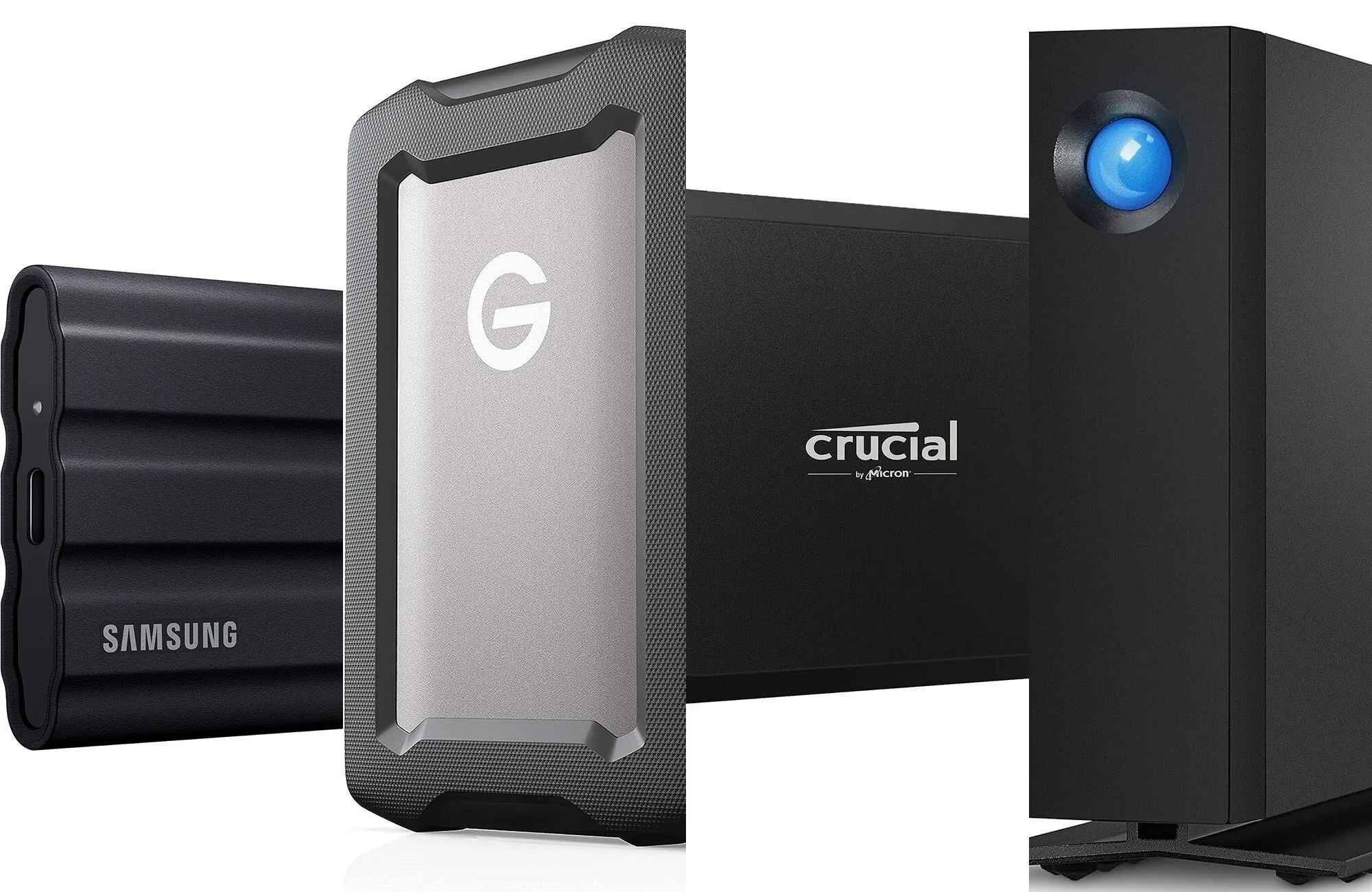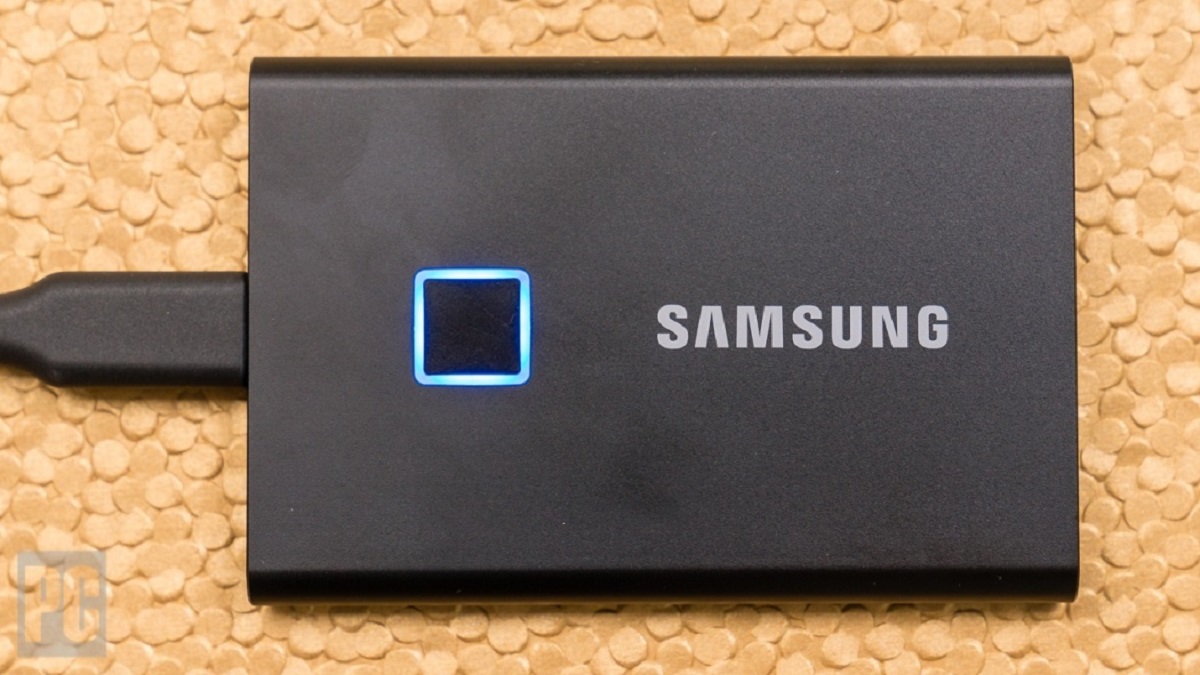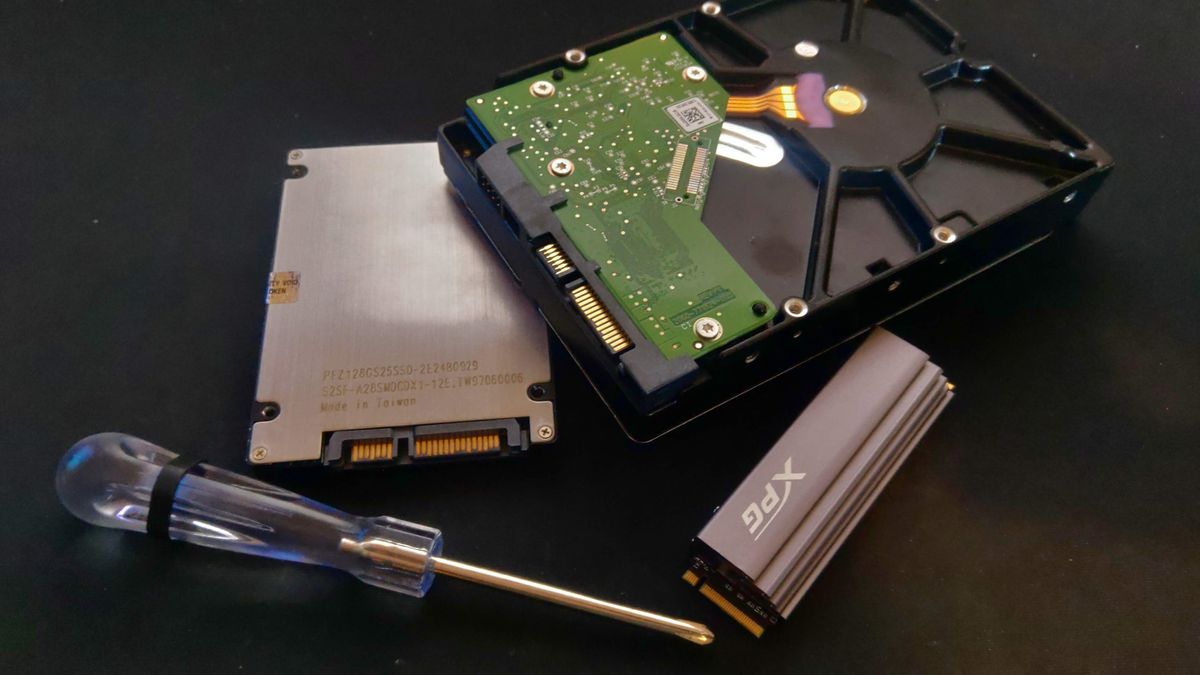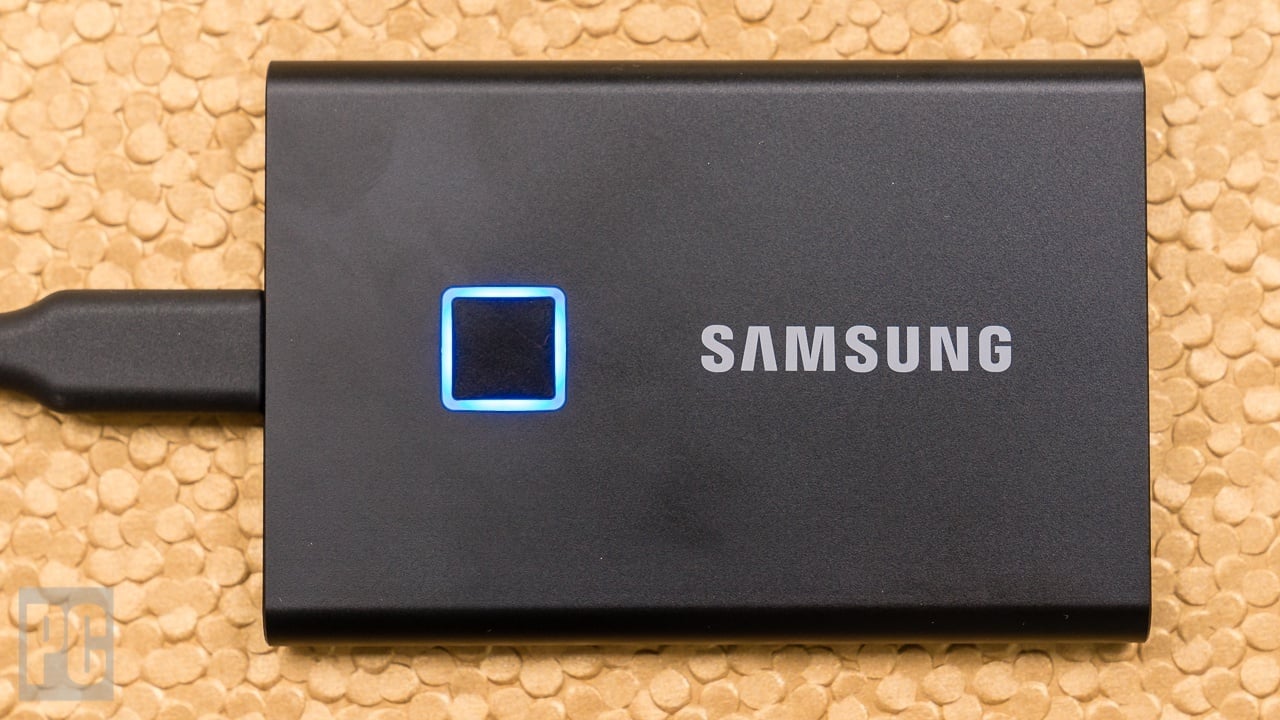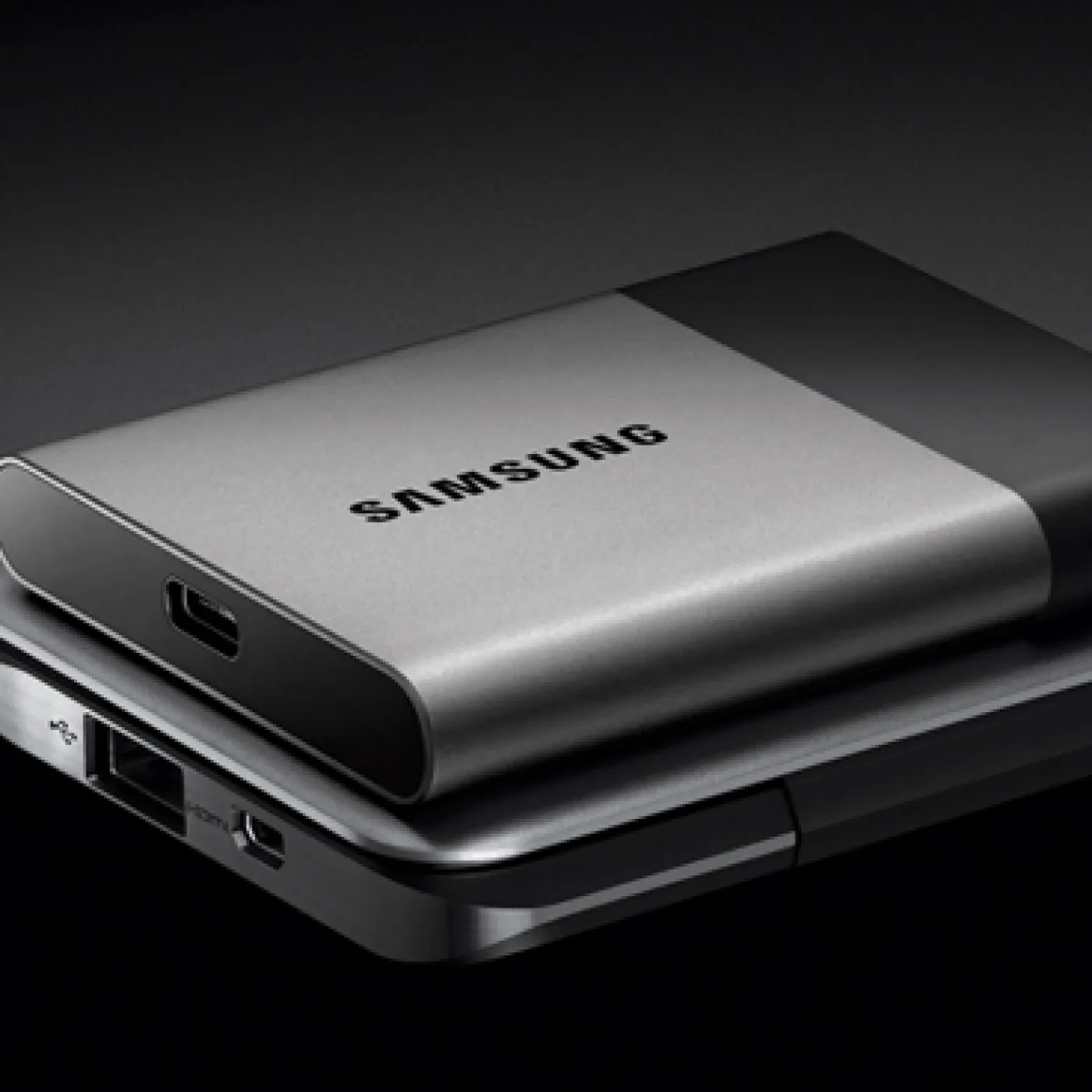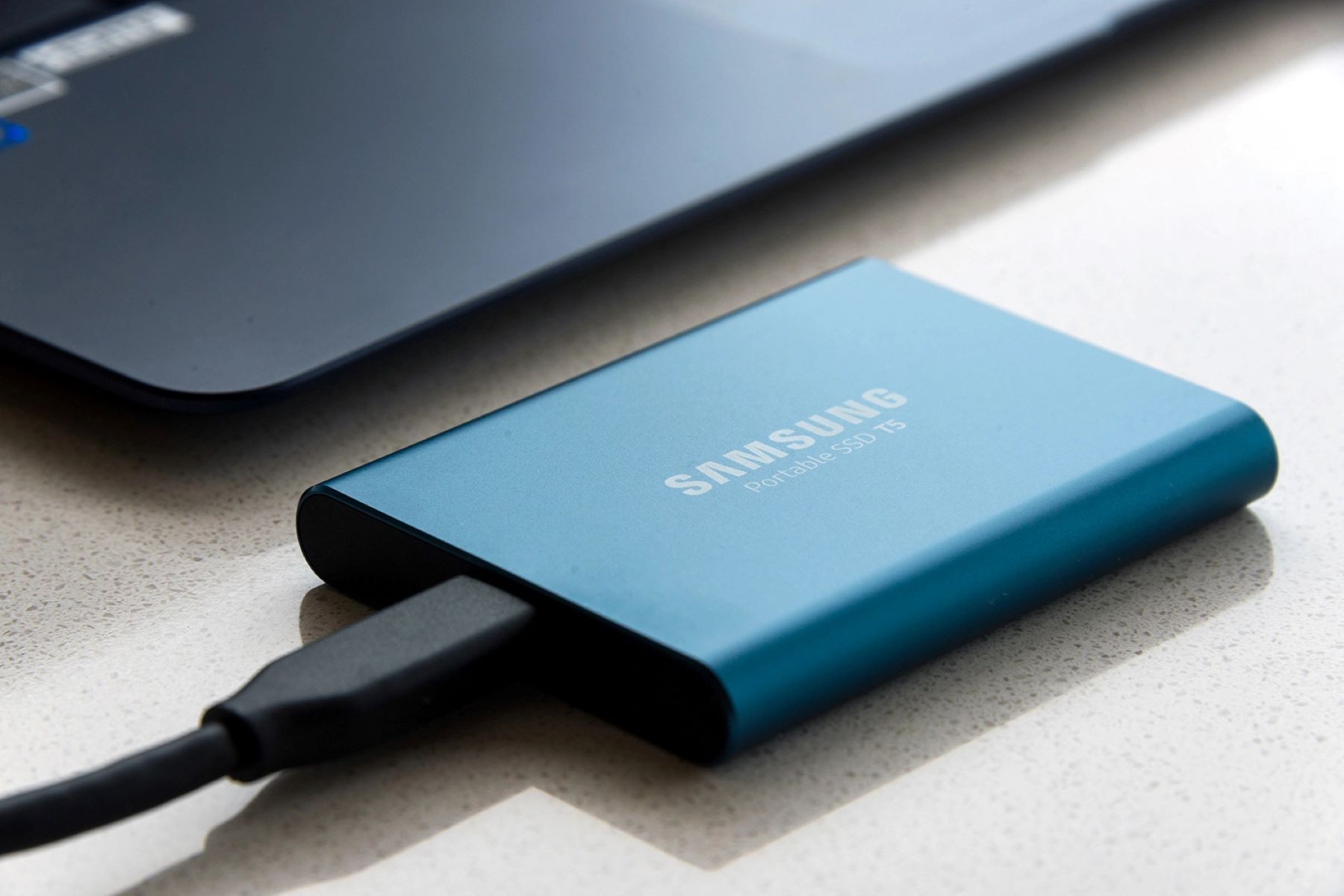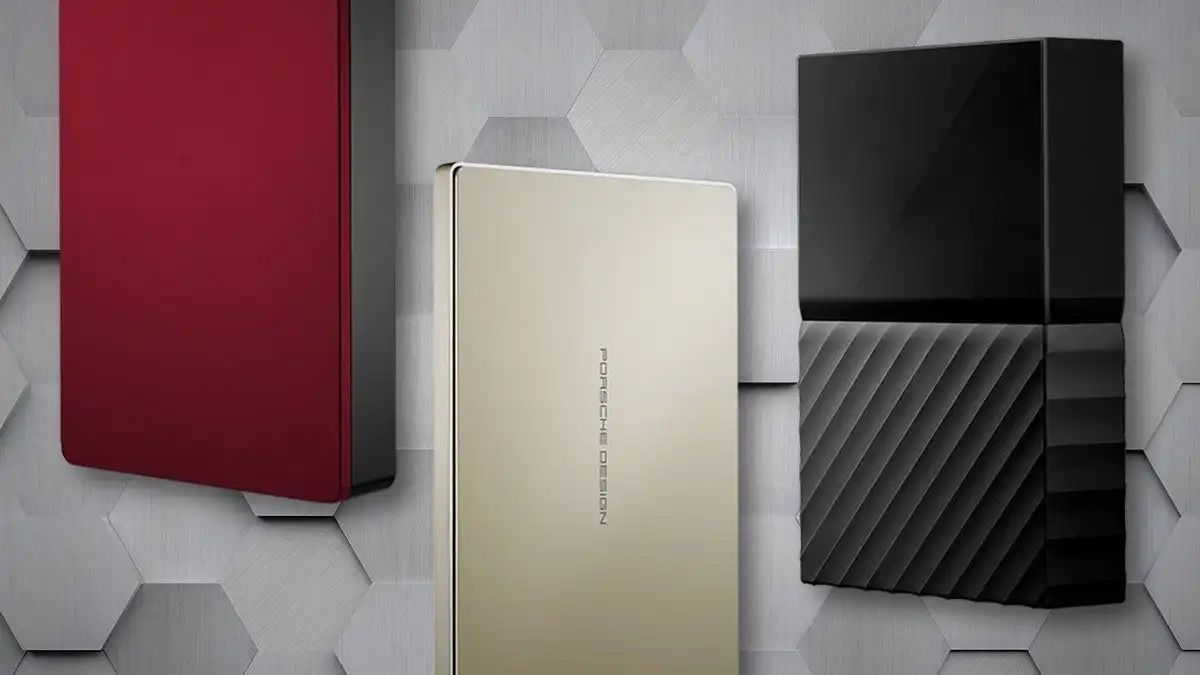What is an External SSD?
An external SSD, or solid-state drive, is a portable storage device that uses flash memory to store and access data. Unlike traditional hard disk drives (HDD), which rely on spinning disks and mechanical parts, SSDs offer significantly faster read and write speeds, making them an ideal choice for those who need quick and reliable access to their files.
External SSDs are compact and lightweight, designed to be easily connected to a variety of devices such as laptops, desktop computers, and even smartphones or tablets. They provide a convenient way to expand storage capacity and transfer files between different devices without relying on cloud-based solutions or internet connectivity.
These drives typically connect to your device via USB, with options ranging from USB 2.0 to the faster USB 3.0 or the latest USB-C interface. USB 3.0 and USB-C interfaces offer much faster data transfer speeds compared to older versions, allowing for quick backups, file transfers, and seamless multimedia playback.
External SSDs come in various storage capacities, ranging from a few hundred gigabytes (GB) to multiple terabytes (TB). This wide range ensures that users can choose a capacity that suits their needs, whether it’s for storing documents, photos, videos, or even large software applications.
Additionally, external SSDs are known for their durability and shock resistance. Since SSDs have no moving parts, they are more resistant to physical damage caused by drops or vibrations, making them a reliable choice for individuals who frequently travel or need a robust storage solution for on-the-go usage.
Overall, an external SSD combines the benefits of speed, compactness, and durability, making it an excellent storage option for a wide range of users, including professionals, students, photographers, and anyone who needs reliable and portable storage for their digital files.
Benefits of Using an External SSD
Using an external SSD offers several advantages over traditional storage options such as HDDs. Here are some of the key benefits:
- Fast data transfer speeds: One of the primary advantages of using an external SSD is its blazing-fast data transfer speeds. SSDs can read and write data much quicker than HDDs, resulting in faster file transfers, quicker backups, and seamless multimedia playback. This speed boost can significantly improve your workflow efficiency and save you valuable time.
- Portability: External SSDs are designed to be compact and lightweight, making them highly portable. They easily fit into your pocket or bag, allowing you to take your files with you wherever you go. Whether you’re a student, professional, or traveler, having your important data readily available at all times can be invaluable.
- Reliability and durability: Unlike traditional HDDs, which are more prone to mechanical failures, external SSDs are built with solid-state technology, eliminating the risk of damage caused by moving parts. They are not only more reliable but also more resistant to physical shocks, making them a suitable choice for individuals on the go.
- Noiseless operation: Another advantage of SSDs is their quiet operation. Since there are no spinning disks, SSDs produce virtually no noise, creating a more peaceful and distraction-free working environment.
- Low power consumption: SSDs consume less power compared to traditional HDDs. This not only leads to longer battery life for laptops and portable devices but also translates into energy savings and reduced electricity bills.
- Compatibility: External SSDs are compatible with a wide range of devices, including laptops, desktop computers, gaming consoles, and even smartphones and tablets. They can be easily connected and used across multiple platforms, making them a versatile storage option.
With these benefits, it’s no wonder that external SSDs are becoming increasingly popular among individuals and professionals who value speed, portability, and reliability in their data storage solutions.
Getting Started with an External SSD
If you’ve recently purchased an external SSD or are planning to get one, here are the steps to get started:
- Check compatibility: Before using your external SSD, ensure that it is compatible with your device. Most SSDs support a USB connection, so make sure your device has a corresponding USB port.
- Connect the SSD: Use the provided USB cable to connect the external SSD to your device. Depending on the type of SSD, you may need to use a USB-A, USB-C, or Thunderbolt cable. Ensure that the connection is secure.
- Power on the SSD: Some external SSDs may require an additional power source, while others are powered directly through the USB connection. Refer to the manufacturer’s instructions to properly power on the SSD.
- Formatting the SSD: In most cases, the external SSD will come unformatted, meaning it needs to be initialized before use. To do this, access your device’s disk management utility (e.g., Disk Management in Windows, Disk Utility on Mac) and format the SSD using the appropriate file system (usually NTFS or exFAT for compatibility).
- Transferring files: Once the SSD is formatted, you can begin transferring files to it. Simply drag and drop the desired files or use the copy and paste function to move your data to the SSD. You can organize your files into folders for better organization.
- Ejecting the SSD: Before disconnecting the external SSD from your device, it is crucial to properly eject it to avoid data corruption or loss. Use the safe removal option in your operating system to eject the SSD before physically disconnecting it.
- Storing and protecting the SSD: When not in use, it’s essential to store your external SSD in a safe and secure place. Consider investing in a protective case to safeguard it from scratches, dust, and other potential damage.
- Regular backups: To ensure that your data is always protected, maintain regular backups of your external SSD. This can be done by periodically synchronizing it with your computer or using cloud storage services for added redundancy.
By following these steps, you can quickly set up and start using your external SSD, enjoying the benefits of increased storage capacity, faster data transfers, and reliable performance.
Connecting an External SSD to Your Device
Connecting an external SSD to your device is a straightforward process. Follow these steps to establish a connection:
- Check available ports: Determine the type of ports available on your device. Most external SSDs use USB connections, so you’ll need a corresponding USB port on your device. Check if it’s a USB-A, USB-C, or Thunderbolt port.
- Select the appropriate cable: Depending on the port on your device and the connector on your external SSD, choose the suitable cable. If your device and SSD have different connection types, you may need an adapter or a cable that can bridge the gap.
- Connect the cable: Plug one end of the cable into the external SSD and the other end into the USB port on your device. Ensure a secure connection to prevent accidental disconnection during data transfer.
- Power on the SSD: Some external SSDs draw power directly from the USB connection, while others require an additional power source. Ensure the SSD is powered on according to the manufacturer’s instructions.
- Wait for device recognition: Once connected, your device should recognize the external SSD automatically. You may hear a sound indicating a successful connection, and the SSD should appear as a removable storage device in your file explorer or desktop.
- Access the SSD: Open the file explorer or your device’s storage management utility to access the files on the external SSD. You can now transfer, view, or modify files stored on the SSD just like you would with any other storage device.
It’s important to note that the specific steps may vary slightly depending on your device’s operating system and the model of the external SSD. However, the basic process remains the same.
If you encounter any difficulties or the SSD is not recognized by your device, ensure that the cables are securely connected, try using a different USB port, or consult the manufacturer’s instructions for troubleshooting tips specific to your model.
By following these steps, you can easily connect your external SSD to your device and take advantage of its fast and reliable storage capabilities.
Formatting Your External SSD
Formatting your external SSD is an important step before you begin using it. Here’s how you can format your external SSD:
- Determine your operating system: Different operating systems have different file system requirements. Identify the operating system(s) you plan to use with your external SSD.
- Backup your data (if applicable): If you have any existing data on the external SSD that you want to keep, make sure to back it up to another storage device or cloud storage before formatting. Formatting will erase all data on the SSD.
- Access the disk management utility: On a Windows computer, you can access the disk management utility by right-clicking the Start button and selecting “Disk Management.” On a Mac, open “Disk Utility” from the “Utilities” folder within the “Applications” folder.
- Select the external SSD: In the disk management utility, locate the external SSD. It should be listed as a separate disk or drive.
- Choose the file system: Right-click on the SSD and select the option to format or initialize it. Choose the appropriate file system for your needs, such as NTFS for Windows or exFAT for cross-platform compatibility.
- Assign a drive letter (Windows only): If you’re using a Windows computer, you can assign a drive letter to the formatted SSD. This makes it easier to identify and access the SSD when connected to your computer.
- Confirm the formatting: Review the settings and confirm the formatting operation. Be aware that this will erase all data on the SSD.
- Wait for the formatting process: The formatting process may take a few moments or longer, depending on the size of the SSD. Once completed, you will receive a notification confirming the successful formatting.
After the external SSD is formatted, it is ready to be used for storing and accessing your files. You can now transfer your data to the SSD or use it as an additional backup or storage solution.
Remember, formatting your SSD will erase all data, so double-check that you have a backup of any important files before proceeding. If you’re unsure about the formatting process or encounter any issues, consult the manufacturer’s instructions or seek assistance from technical support.
By properly formatting your external SSD, you can ensure compatibility with your operating system and optimize its performance for reliable data storage and retrieval.
Transferring Files to an External SSD
Transferring files to your external SSD is a simple process that allows you to keep your data organized and accessible. Here’s how you can transfer files to an external SSD:
- Connect the external SSD: Plug your external SSD into your device using the appropriate cable. Ensure a secure connection.
- Locate the files to transfer: Identify the files or folders you want to transfer to the SSD. They can be located in your device’s internal storage or another connected storage device.
- Select and copy: Use your device’s file explorer or another file management tool to select the files or folders you wish to transfer. Right-click and choose the “Copy” option or use the keyboard shortcut (e.g., Ctrl+C on Windows, Command+C on Mac).
- Navigate to the SSD: Open another file explorer window or tab and navigate to the external SSD. This can usually be found under “My Computer” (Windows) or in the sidebar under “Devices” (Mac).
- Paste files: Right-click within the SSD’s file explorer window and choose the “Paste” option or use the keyboard shortcut (e.g., Ctrl+V on Windows, Command+V on Mac) to paste the files onto the SSD.
- Wait for the transfer: The time it takes to transfer files will depend on the size and number of files being transferred, as well as the speed of the SSD and USB connection. Be patient and avoid interrupting the transfer process.
- Verify the transfer: Once the transfer is complete, navigate to the SSD and ensure that the transferred files are present and intact. Open a few files to confirm their accessibility and integrity.
Transferring files to an external SSD provides several benefits, including freeing up space on your device’s internal storage, creating backups, and enabling easy access to your files across multiple devices.
Keep in mind that it’s important to safely eject the external SSD from your device before physically disconnecting it to avoid data corruption. Using the appropriate option in your operating system, safely remove the SSD before unplugging it.
By following these steps, you can easily transfer files to your external SSD, ensuring that your data is secure, organized, and readily accessible when you need it.
Safely Ejecting an External SSD
Properly ejecting your external SSD before disconnecting it from your device is essential to prevent data corruption or loss. Follow these steps to safely eject your external SSD:
- Save and close any open files: Before ejecting the external SSD, make sure to save and close any files that you may have open on it. This ensures that all changes are saved and reduces the risk of data loss or corruption.
- Locate the eject option: In your operating system’s file explorer or storage management utility, locate the external SSD. You can typically find it listed as a removable storage device.
- Safely eject the SSD: Right-click on the external SSD and select the option to safely eject or safely remove the device. This option may vary depending on your operating system, but it is usually labeled with an icon resembling a USB device being unplugged.
- Wait for confirmation: After initiating the safe eject process, wait for the operating system to confirm that it is safe to remove the SSD. You may receive a notification or see a message indicating that it is now safe to disconnect the device.
- Disconnect the SSD: Once you have received confirmation, you can safely disconnect the external SSD from your device. Gently remove the cable from both the SSD and the device’s USB port.
It is important to note that prematurely disconnecting an external SSD without following the proper ejection process can lead to data corruption or loss. While modern operating systems have mechanisms in place to protect against this, it is always best to err on the side of caution and safely eject the SSD.
By safely ejecting your external SSD, you ensure that all data is written and saved, minimizing the risk of data integrity issues. This practice helps maintain the reliability and performance of your SSD for long-term usage.
Remember to always follow the manufacturer’s instructions and consult the documentation specific to your external SSD model for any additional guidelines or recommendations related to safely ejecting the device.
Optimizing the Performance of Your External SSD
To maximize the performance and lifespan of your external SSD, there are several steps you can take. Here are some tips to optimize the performance of your external SSD:
- Use the latest USB interface: If your device supports it, use the fastest available USB interface for your external SSD, such as USB 3.0 or USB-C. These interfaces provide faster data transfer speeds, allowing you to take full advantage of your SSD’s capabilities.
- Ensure proper cable connection: Make sure your external SSD is securely connected to your device using a compatible cable. Loose or faulty connections can lead to slower performance or even data transfer interruptions.
- Firmware updates: Check for firmware updates regularly for your external SSD. Manufacturers often release firmware updates to improve performance, compatibility, and stability. Visit the manufacturer’s website or use their dedicated software to check for and install any available updates.
- Enable TRIM (Windows users): If you are using a Windows computer, ensure that the TRIM command is enabled. TRIM helps optimize the SSD’s performance by allowing the operating system to inform the SSD which blocks of data are no longer in use and can be erased, enhancing overall efficiency.
- Manage storage capacity: Avoid filling your external SSD to its maximum capacity. Leaving some free space on the SSD allows for better performance and helps prolong its lifespan. Consider periodically offloading less frequently accessed files to another storage device or utilizing cloud storage options.
- Regularly update your operating system: Keeping your operating system up to date ensures that you have the latest drivers and performance optimizations. Operating system updates often include enhancements specifically designed for storage devices, including external SSDs.
- Protect your SSD from physical damage: Shield your external SSD from excessive heat, moisture, and impact. Use a protective case or cover when transporting it, and avoid exposing it to extreme temperatures. Physical damage can negatively impact the performance and reliability of your SSD.
- Scan for and repair disk errors: Periodically perform disk error scanning and repair utilities provided by your operating system. These utilities can identify and fix any disk errors that may have occurred, preventing potential performance issues and data loss.
- Defragmentation is not necessary: Unlike traditional HDDs, SSDs do not require defragmentation. In fact, running defragmentation utilities on an SSD can contribute to unnecessary wear and tear on the drive. SSDs have their own internal mechanisms for managing data placement, eliminating the need for defragmentation.
By following these optimization tips, you can ensure that your external SSD operates at its peak performance, delivering fast data transfer speeds and reliable storage for your files.
Troubleshooting Common Issues with an External SSD
While external SSDs are generally reliable, you may encounter some common issues along the way. Here are some troubleshooting tips to help you address these issues:
- Ensure proper connection: If your external SSD is not being recognized by your device, double-check that it is properly connected. Try unplugging and re-plugging the USB cable, making sure it is securely inserted into both the SSD and your device.
- Update device drivers: Outdated or incompatible device drivers can cause issues with your external SSD. Check for driver updates from your device manufacturer’s website or utilize automatic driver update software to keep your drivers up to date.
- Check USB port and cable: Faulty USB ports or cables can result in connectivity issues. Try connecting the SSD to different USB ports on your device or use a different cable to determine if the problem lies with the port or cable.
- Format compatibility: Ensure that the file system format of your external SSD is compatible with your device’s operating system. If not, you may need to format the SSD to a compatible file system (e.g., NTFS, exFAT). Backup your data before formatting as it will erase all files on the SSD.
- Scan for viruses: Run a thorough virus scan on your device to ensure that malware or malicious software is not causing any issues with your external SSD. Viruses can sometimes interfere with device recognition or slow down overall performance.
- Power supply: If your external SSD requires additional power, make sure that it is receiving adequate power supply. Check the power source and cables to ensure they are functioning properly.
- Check for firmware updates: Visit the manufacturer’s website to see if any firmware updates are available for your external SSD. Firmware updates often address performance or compatibility issues and can improve overall stability.
- Test on another device: If possible, test your external SSD on another compatible device. This helps determine if the issue is with the SSD itself or if it is related to your specific device or configuration.
- Seek professional assistance: If you have tried the above troubleshooting steps and are still experiencing issues with your external SSD, consider reaching out to the manufacturer’s customer support or consulting a professional technician. They can provide specialized guidance or repair services.
By following these troubleshooting tips, you can address common issues with your external SSD and restore its functionality. Remember to always back up your data before attempting any troubleshooting steps to avoid potential data loss.
External SSD Recommendations
With the multitude of options available in the market, choosing the right external SSD can be overwhelming. Here are some recommendations to help you find a reliable and high-performance external SSD:
- Samsung T5: The Samsung T5 is a popular choice known for its sleek design, fast transfer speeds, and excellent durability. It offers various storage capacities and is compatible with both USB-C and USB-A interfaces.
- SanDisk Extreme Portable SSD: The SanDisk Extreme Portable SSD delivers ruggedness and speed. It is lightweight, compact, and equipped with password protection and encryption for added security.
- Crucial X8: The Crucial X8 combines performance and affordability. Offering high-speed transfers, this SSD is ideal for multimedia professionals and gamers who require fast access to large files.
- WD My Passport SSD: The WD My Passport SSD delivers reliable performance and secure data encryption. It has a compact design, supports USB-C connectivity, and comes with a suite of backup software.
- Seagate Fast SSD: The Seagate Fast SSD offers impressive read and write speeds, making it suitable for content creators and professionals who require fast data transfers. It has a lightweight design and comes with USB-C connectivity for enhanced convenience.
When choosing an external SSD, consider factors such as storage capacity, transfer speeds, compatibility with your devices, durability, and price. It’s important to assess your specific needs and use cases to find the best fit for your requirements.
Additionally, read user and expert reviews to gain insights into the performance and reliability of different external SSD models. These reviews can help validate the claims made by manufacturers and provide a more comprehensive understanding of the product.
Before making a purchase, evaluate the warranty and customer support options offered by the manufacturer. A longer warranty period and responsive customer support can provide added peace of mind in case you encounter any issues with your external SSD.
Remember that while these recommendations are meant to help you in your decision-making process, it’s essential to prioritize your own specific needs and preferences when choosing an external SSD that best fits your requirements.
Final Thoughts on Using an External SSD
Using an external SSD can greatly enhance your storage capabilities and improve your overall computing experience. Here are some final thoughts on the benefits of using an external SSD:
Speed and Performance: One of the most significant advantages of using an external SSD is the speed and performance it offers. With faster read and write speeds compared to traditional HDDs, you can enjoy quicker file transfers, faster application launches, and seamless multimedia playback. This can greatly boost your productivity and convenience.
Portability and Convenience: External SSDs are designed to be compact and lightweight, making them highly portable. You can easily carry your valuable data with you, whether you’re a student, professional, or traveler. They provide on-the-go access to your files without relying on an internet connection or cloud storage, giving you the freedom and convenience to work or play anywhere.
Reliability and Durability: Unlike traditional HDDs, external SSDs have no moving parts, making them more durable and resistant to physical shocks. They are less prone to damage from drops, bumps, or vibrations, providing you with a reliable storage solution that can withstand the rigors of daily use and travel.
Expandable Storage: With external SSDs, you can easily expand your device’s storage capacity. Whether you need extra space for documents, photos, videos, or large software applications, external SSDs offer a range of storage capacities to suit your needs. This allows you to free up space on your device’s internal storage and keep your files organized.
Data Security: External SSDs often come with features such as password protection and encryption, ensuring the security and privacy of your stored data. These measures provide an added layer of protection, giving you peace of mind that your sensitive files are safeguarded against unauthorized access or theft.
Overall, incorporating an external SSD into your storage setup is a wise investment that brings numerous benefits. Whether you’re a student, professional, content creator, or casual user, an external SSD offers you the speed, convenience, and reliability you need to efficiently manage your files and elevate your computing experience.
Remember to research and choose an external SSD that aligns with your specific requirements, considering factors such as storage capacity, transfer speeds, compatibility, and price. With proper care and maintenance, your external SSD can serve as a reliable and efficient storage solution for years to come.









